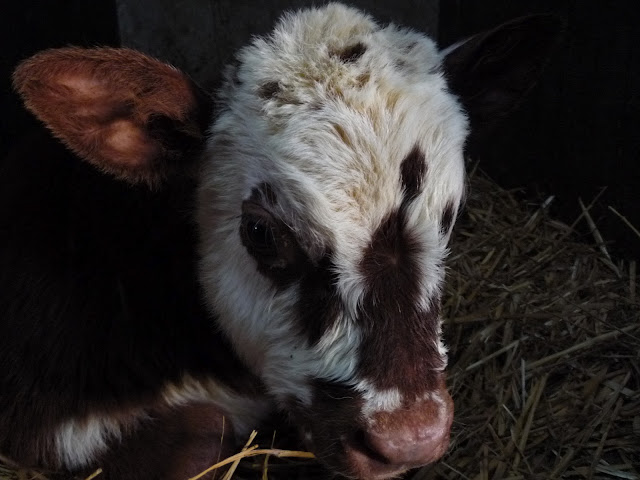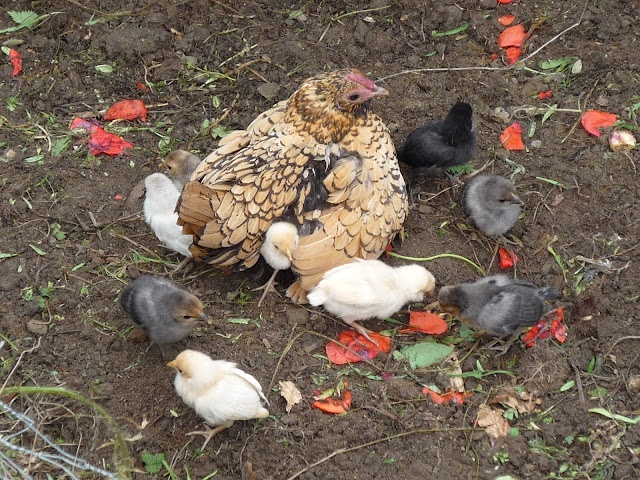
(Perhaps one of the most famous breeders of the Black Hamburg was L. Frank Baum, author of The Wonderful Wizard of Oz. In his sequel to the latter he replaced Dorothy's companion Toto with Billina, a hen, whose character is thought to be drawn from his experience in raising Hamburgs.)
Old breeds versus New Money

Making hay whilst the sun still shines on the small farmer in the early 30's. My Grandmother atop the hay wain.

City meets Country between the Wars. My great Aunt down on the Farm having come up from the Bright Lights of London.
The Farmyard and Barnyard at War
 This ancient race was brought to Normandy by the Vikings in the 9th century but conflict in Normandy during WWII, decimated the breed. Florence (above) is a new addition to the dairy herd on the organic farm, where I buy my grain, as are those below from a local organic farm, where I buy my raw organic milk.
This ancient race was brought to Normandy by the Vikings in the 9th century but conflict in Normandy during WWII, decimated the breed. Florence (above) is a new addition to the dairy herd on the organic farm, where I buy my grain, as are those below from a local organic farm, where I buy my raw organic milk.In the wake of both World Wars, came the concerted push to try out all the new chemical and mechanical farming systems, which had their inception prior to WW1 but advanced in leaps and bounds after 1945. Subsidies were created purely to fund farmers in the use of these chemicals and hedges and habitats were ripped out to make way for the giant bank-funded machinery. In a World of Agrochemicals and Intensive Farming, a slow growing, independently-minded, hardy forager, had no place and ancient breeds of poultry, for example, were systematically downgraded to 'hobby hens' purely for exhibition and show. Intensive indoor systems required docile, plain-feathered birds, who could survive and lay in close confinement, the White Leghorn was in the ascendancy. Finally, even this warm-weather breed from Italy could not suffice as a laying machine and new hybrids both for meat and laying came out of the laboratory and onto the market. Meat breeds were created, which had been devised to sit at food troughs eating 24/7 and killed at 41 days and hens which sat, laid and lived in a cage no bigger than a sheet of A4 paper and so it continues, to featherless GMO hens. To summarise, two forces in Agriculture and Horticulture have been at war ever since the actual World Wars. There can be no quarter given, they are diametrically opposed, the philosophy of each precluding the existence of the other. In recent years and to back up the organic farming movement has arisen the organic homesteader, permaculturist and biodynamic backyard farmer, who is a supporter of old breeds, old methods and old skills. On the side of the Agrochemical industry are the Biotech companies, patenting the gene pool, limiting, standardising and globalising production and increasing the use of chemicals. Today the stakes are even higher.
The Second Agrarian Revolution and Backyard Organics
 As more and more people come to understand the important effect of food on their health and happiness the more questions will be asked as to how that food is produced. In the meantime an increasing number of us are deciding that as food is the most important factor to sustain life, then we would be better off producing it ourselves. If you are going to do this, then you really have to be organic, otherwise all the hard work and effort you put in, will still produce an inferior product. There is also an added bonus beyond the production of good quality food and that is the insight keeping poultry gives into the workings of not only an avian society but also of our own. Studying hens is far from boring, their societies and relationships are incredibly complex and individually and as a group they are capable of adapting to change with a logic which is startling. Here below, a group of hens sunbathing together, make the vital production of vitamin D3 into a social event!
As more and more people come to understand the important effect of food on their health and happiness the more questions will be asked as to how that food is produced. In the meantime an increasing number of us are deciding that as food is the most important factor to sustain life, then we would be better off producing it ourselves. If you are going to do this, then you really have to be organic, otherwise all the hard work and effort you put in, will still produce an inferior product. There is also an added bonus beyond the production of good quality food and that is the insight keeping poultry gives into the workings of not only an avian society but also of our own. Studying hens is far from boring, their societies and relationships are incredibly complex and individually and as a group they are capable of adapting to change with a logic which is startling. Here below, a group of hens sunbathing together, make the vital production of vitamin D3 into a social event!
Here are some tiny gardeners. After our Wild poppy border had died back I used Lucky and her chicks to clear the ground before planting out a salad crop. The tiny feet do little damage to the soil structure but their big appetites clear the ground of wireworms and woodlice.
Thanks for dropping by and do feel free to share experiences or ask for further information in the comment section. If you have enjoyed this piece and found it useful think about sharing it with your family and friends, on social media and also maybe about joining this blog and/or subscribing to my Youtube, Odysee or BitChute Channel or even supporting us on Patreon or
Until next time, all the very best from sunny Normandie!
RELATED POSTS
Polish Crested - Beauty, Brains and Rusticity.
RETURN TO CONTENTS PAGE
© Holistic Hen 2015











